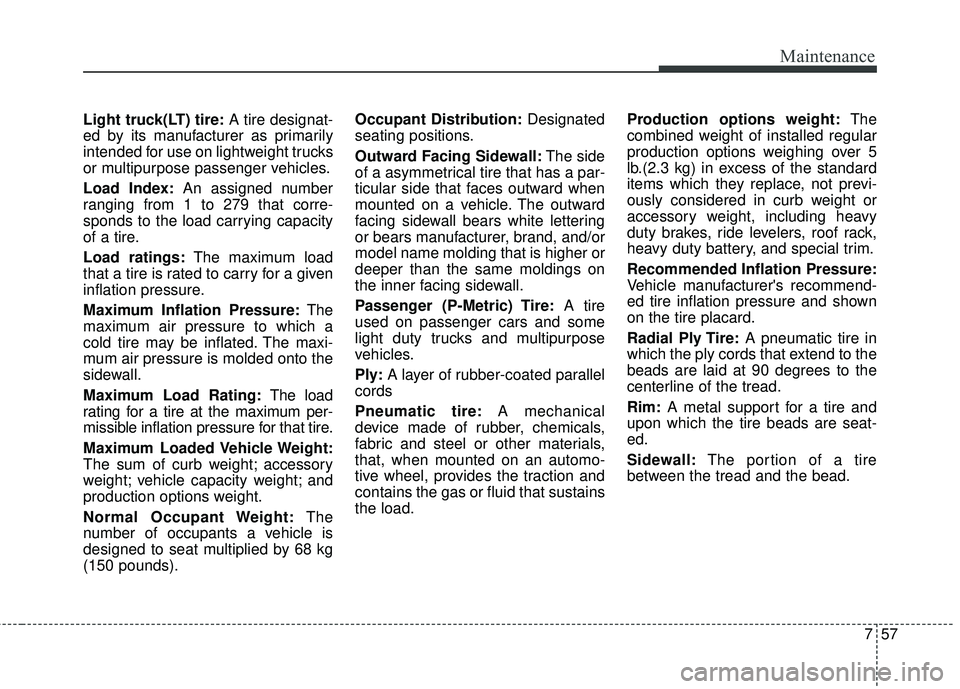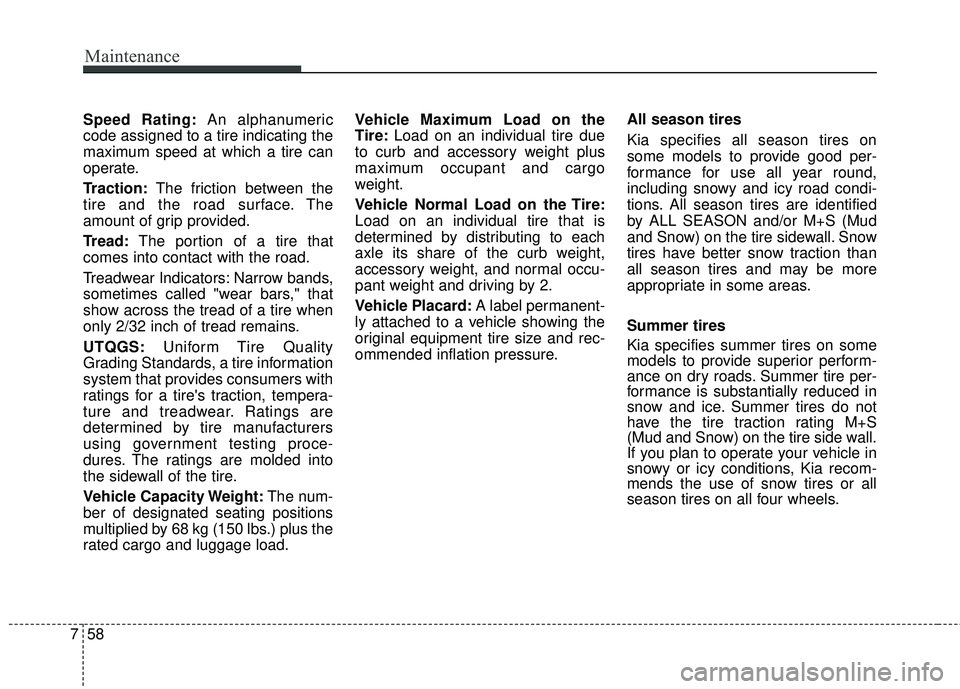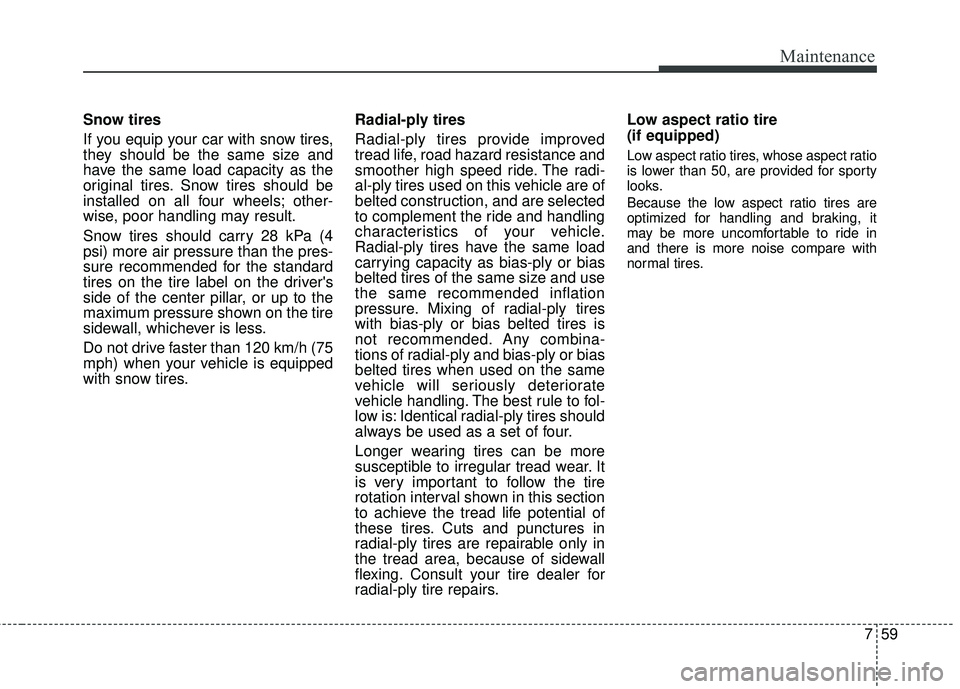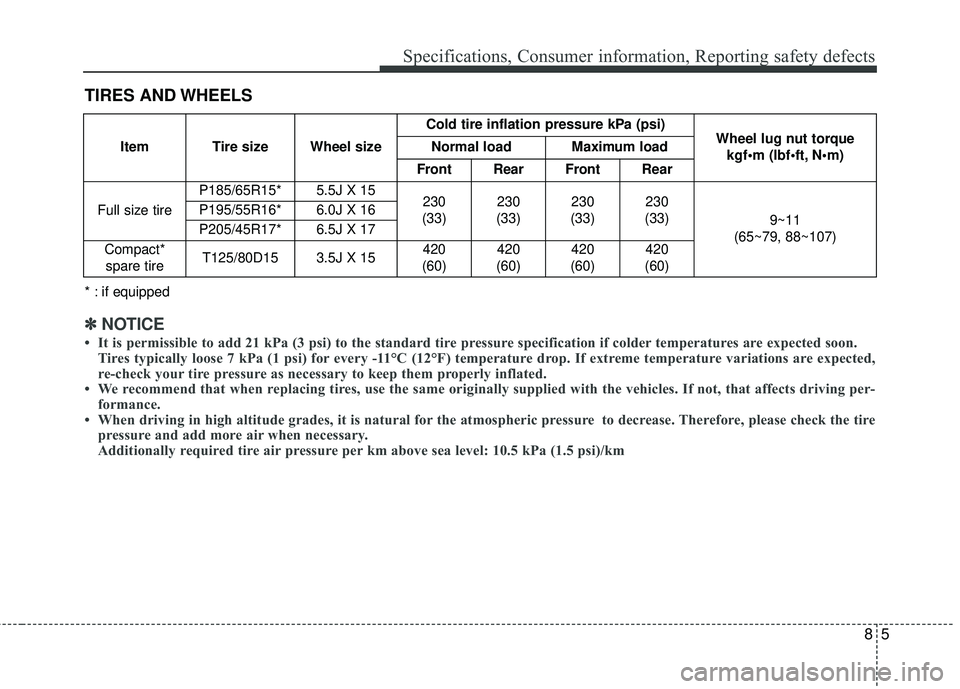2017 KIA RIO inflation pressure
[x] Cancel search: inflation pressurePage 393 of 449

757
Maintenance
Light truck(LT) tire:A tire designat-
ed by its manufacturer as primarily
intended for use on lightweight trucks
or multipurpose passenger vehicles.
Load Index: An assigned number
ranging from 1 to 279 that corre-
sponds to the load carrying capacity
of a tire.
Load ratings: The maximum load
that a tire is rated to carry for a given
inflation pressure.
Maximum Inflation Pressure: The
maximum air pressure to which a
cold tire may be inflated. The maxi-
mum air pressure is molded onto the
sidewall.
Maximum Load Rating: The load
rating for a tire at the maximum per-
missible inflation pressure for that tire.
Maximum Loaded Vehicle Weight:
The sum of curb weight; accessory
weight; vehicle capacity weight; and
production options weight.
Normal Occupant Weight: The
number of occupants a vehicle is
designed to seat multiplied by 68 kg
(150 pounds). Occupant Distribution:
Designated
seating positions.
Outward Facing Sidewall: The side
of a asymmetrical tire that has a par-
ticular side that faces outward when
mounted on a vehicle. The outward
facing sidewall bears white lettering
or bears manufacturer, brand, and/or
model name molding that is higher or
deeper than the same moldings on
the inner facing sidewall.
Passenger (P-Metric) Tire: A tire
used on passenger cars and some
light duty trucks and multipurpose
vehicles.
Ply: A layer of rubber-coated parallel
cords
Pneumatic tire: A mechanical
device made of rubber, chemicals,
fabric and steel or other materials,
that, when mounted on an automo-
tive wheel, provides the traction and
contains the gas or fluid that sustains
the load. Production options weight:
The
combined weight of installed regular
production options weighing over 5
lb.(2.3 kg) in excess of the standard
items which they replace, not previ-
ously considered in curb weight or
accessory weight, including heavy
duty brakes, ride levelers, roof rack,
heavy duty battery, and special trim.
Recommended Inflation Pressure:
Vehicle manufacturer's recommend-
ed tire inflation pressure and shown
on the tire placard.
Radial Ply Tire: A pneumatic tire in
which the ply cords that extend to the
beads are laid at 90 degrees to the
centerline of the tread.
Rim: A metal support for a tire and
upon which the tire beads are seat-
ed.
Sidewall: The portion of a tire
between the tread and the bead.
Page 394 of 449

Maintenance
58
7
Speed Rating: An alphanumeric
code assigned to a tire indicating the
maximum speed at which a tire can
operate.
Traction: The friction between the
tire and the road surface. The
amount of grip provided.
Tread: The portion of a tire that
comes into contact with the road.
Treadwear Indicators: Narrow bands,
sometimes called "wear bars," that
show across the tread of a tire when
only 2/32 inch of tread remains.
UTQGS: Uniform Tire Quality
Grading Standards, a tire information
system that provides consumers with
ratings for a tire's traction, tempera-
ture and treadwear. Ratings are
determined by tire manufacturers
using government testing proce-
dures. The ratings are molded into
the sidewall of the tire.
Vehicle Capacity Weight: The num-
ber of designated seating positions
multiplied by 68 kg (150 lbs.) plus the
rated cargo and luggage load. Vehicle Maximum Load on the
Tire:
Load on an individual tire due
to curb and accessory weight plus
maximum occupant and cargo
weight.
Vehicle Normal Load on the Tire:
Load on an individual tire that is
determined by distributing to each
axle its share of the curb weight,
accessory weight, and normal occu-
pant weight and driving by 2.
Vehicle Placard: A label permanent-
ly attached to a vehicle showing the
original equipment tire size and rec-
ommended inflation pressure. All season tires
Kia specifies all season tires on
some models to provide good per-
formance for use all year round,
including snowy and icy road condi-
tions. All season tires are identified
by ALL SEASON and/or M+S (Mud
and Snow) on the tire sidewall. Snow
tires have better snow traction than
all season tires and may be more
appropriate in some areas.
Summer tires
Kia specifies summer tires on some
models to provide superior perform-
ance on dry roads. Summer tire per-
formance is substantially reduced in
snow and ice. Summer tires do not
have the tire traction rating M+S
(Mud and Snow) on the tire side wall.
If you plan to operate your vehicle in
snowy or icy conditions, Kia recom-
mends the use of snow tires or all
season tires on all four wheels.
Page 395 of 449

759
Maintenance
Snow tires
If you equip your car with snow tires,
they should be the same size and
have the same load capacity as the
original tires. Snow tires should be
installed on all four wheels; other-
wise, poor handling may result.
Snow tires should carry 28 kPa (4
psi) more air pressure than the pres-
sure recommended for the standard
tires on the tire label on the driver's
side of the center pillar, or up to the
maximum pressure shown on the tire
sidewall, whichever is less.
Do not drive faster than 120 km/h (75
mph) when your vehicle is equipped
with snow tires.Radial-ply tires
Radial-ply tires provide improved
tread life, road hazard resistance and
smoother high speed ride. The radi-
al-ply tires used on this vehicle are of
belted construction, and are selected
to complement the ride and handling
characteristics of your vehicle.
Radial-ply tires have the same load
carrying capacity as bias-ply or bias
belted tires of the same size and use
the same recommended inflation
pressure. Mixing of radial-ply tires
with bias-ply or bias belted tires is
not recommended. Any combina-
tions of radial-ply and bias-ply or bias
belted tires when used on the same
vehicle will seriously deteriorate
vehicle handling. The best rule to fol-
low is: Identical radial-ply tires should
always be used as a set of four.
Longer wearing tires can be more
susceptible to irregular tread wear. It
is very important to follow the tire
rotation interval shown in this section
to achieve the tread life potential of
these tires. Cuts and punctures in
radial-ply tires are repairable only in
the tread area, because of sidewall
flexing. Consult your tire dealer for
radial-ply tire repairs.Low aspect ratio tire
(if equipped)
Low aspect ratio tires, whose aspect ratio
is lower than 50, are provided for sporty
looks.
Because the low aspect ratio tires are
optimized for handling and braking, it
may be more uncomfortable to ride in
and there is more noise compare with
normal tires.
Page 435 of 449

85
Specifications, Consumer information, Reporting safety defects
TIRES AND WHEELS
Item Tire size Wheel sizeCold tire inflation pressure kPa (psi)
Wheel lug nut torque
Normal load Maximum load
Front Rear Front Rear
Full size tire
P185/65R15* 5.5J X 15 230
(33) 230
(33) 230
(33) 230
(33) 9~11
(65~79, 88~107)
P195/55R16* 6.0J X 16
P205/45R17* 6.5J X 17
Compact* spare tire
T125/80D15 3.5J X 15 420
(60) 420
(60) 420
(60) 420
(60)
* : if equipped
✽ ✽ NOTICE
• It is permissible to add 21 kPa (3 psi) to the standard tire pressure specification if colder temperatures are expected soon.
Tires typically loose 7 kPa (1 psi) for every -11°C (12°F) temperature drop. If extreme temperature variations are expected,
re-check your tire pressure as necessary to keep them properly inflated.
• We recommend that when replacing tires, use the same originally supplied with the vehicles. If not, that aff\
ects driving per- formance.
• When driving in high altitude grades, it is natural for the atmospheric pressure to decrease. Therefore, please check the tire pressure and add more air when necessary.
Additionally required tire air pressure per km above sea level: 10.5 kPa (1.5 psi)/km
Page 448 of 449

Index
8I
THEFT-ALARM SYSTEM··················\
··················\
·······4-13Armed stage ··················\
··················\
··················\
···········4-13
Disarmed stage ··················\
··················\
··················\
······4-14
Theft-alarm stage ··················\
··················\
··················\
···4-14
Tire Pressure Monitoring System (TPMS) ··················\
····6-9 Changing a tire with TPMS··················\
··················\
·····6-12
Low tire pressure telltale ··················\
··················\
·········6-10
TPMS (Tire Pressure Monitoring System)malfunction indicator ··················\
··················\
············6-11
Tire specification and pressure label ··················\
···········8-10
Tires and Wheels ··················\
··················\
··················\
·····7-48 All season tires ··················\
··················\
··················\
·····7-58
Checking tire inflation pressure ··················\
················7-49
Low aspect ratio tire ··················\
··················\
················7-59
Radial-ply tires ··················\
··················\
··················\
······7-59
Recommended cold tire inflation pressures ················7-48
Snow tires ··················\
··················\
··················\
··············7-59
Summer tires··················\
··················\
··················\
··········7-58
Tire care ··················\
··················\
··················\
·················7-48\
Tire maintenance ··················\
··················\
··················\
···7-52
Tire replacement ··················\
··················\
··················\
····7-51
Tire rotation ··················\
··················\
··················\
···········7-50
Tire sidewall labeling ··················\
··················\
··············7-53
Tire traction ··················\
··················\
··················\
···········7-52
Wheel alignment and tire balance ··················\
·············7-51
Wheel replacement ··················\
··················\
··················\
7-52
Tires and wheels ··················\
··················\
··················\
········8-5 Towing ··················\
··················\
··················\
··················\
···6-28
Emergency towing ··················\
··················\
··················\
·6-30
Removable towing hook (Front) ··················\
···············6-29
Towing service··················\
··················\
··················\
·······6-28
Trunk (4 Door)··················\
··················\
··················\
·········4-20 Closing the trunk ··················\
··················\
··················\
···4-21
Emergency trunk safety release··················\
·················4-21\
Opening the trunk ··················\
··················\
··················\
··4-20
Vehicle break-in process ··················\
··················\
··············1-5
Vehicle certification label ··················\
··················\
············8-9
Vehicle data collection and event data recorders·············1-6
Vehicle identification number (VIN) ··················\
·············8-9
Vehicle load limit ··················\
··················\
··················\
·····5-53 Certification label ··················\
··················\
··················\
··5-56
Tire and loading information label ··················\
············5-53
Vehicle weight ··················\
··················\
··················\
·········5-58
Washer fluid ··················\
··················\
··················\
·············7-40 Checking the washer fluid level ··················\
················7-40
Weight/Volume ··················\
··················\
··················\
··········8-6
Windows ··················\
··················\
··················\
··················\
4-24 Manual windows ··················\
··················\
··················\
···4-27
Power windows··················\
··················\
··················\
······4-25
V
W